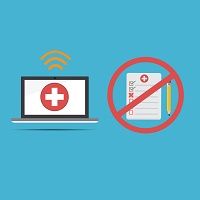Digital Divide: Why Don't More Dentists Use EHRs?
Electronic Health Records are billed as a way to streamline processes and paperwork. So why haven't they take off in America's dental practices?

A report from the Office of the National Coordinator for Health IT reveals that 83% of physicians countrywide have adopted electronic health record systems. So while the adoption rate has been slow over the past few years, it is progressing.
It’s a different story, however, among dental practices, where EHR adoption has been low. Andy Nieto, director of healthcare solutions at DataMotion, which provides secure information transport services and products to businesses, says EHR adoption is a multifold problem in the dental industry.
“Dental practices have an established documentation process which does not lend itself to what I would call clinical or ambulatory medicine EHRs. It’s very specific and unique,” Nieto explains. “Most EHRs are not designed for dentists.”
Design and Incentive
Nieto says that dental EHRs themselves are only advisable or necessary for dentists if they really want to comply with certain billing terms, whether it be a meaningful use compliance issue or something similar. To that end, there’s been no singular driving force to really push dentists to use EHRs, unlike the ambulatory EHRs or hospital EHRs that had money associated with meaningful use.
“There’s been a kind of disconnect,” Nieto says. “Why would a dentist spend the money to deploy an EHR if there’s no stick or carrot really associated with it.”
But aren’t there similar benefits to a dental practice—benefits that medical practices are beginning to realize, such as increased productivity and workflow efficiency? Nieto agrees that there’s always value to having better management access to, and delivery of, information.
“Having said that, the reason I don’t drive a Cadillac right now and I drive a Jeep is because my need is not comfort and style,” he points out. “My need is transport.”
Addressing Needs
Nieto explains that EHRs have been around for years, and their current structure is closed-ended questioning for the purpose of documentation. Dentists, however, do most of their own diagnoses and typically ask open-ended questions, and EHRs typically remove that dialogue.
For example, an EHR has to improve the efficiency of an office. If the dentist has to click on every tooth in order to document each one, and a paper chart allows them to just use a pencil to circle or place a mark on the tooth, which one is more efficient? And which one keeps them facing the patient?
“I don’t think we’re quite there yet when it comes to the ease of use technology at the point of care,” Nieto says. “It’s improving, but I don’t think we’re quite there yet.”
But dentists are a very eager group of professionals, Nieto says. Last fall, DataMotion was selected for the second consecutive year as the technology backbone for demonstrations during ADA 2015 on the secure exchange of digital images and patient records between dentists, dental specialists, other healthcare entities and patients themselves.
“[Dentists] typically are more technology savvy,” Nieto says. “One of the things about dentists is they like the tools, they like the technology, and they like the resources. They’re constantly saying, ‘Teach me. I want to learn more.’”
Making Connections
Nieto points out that in the last five years “it’s been really cool” to see the recognition of dental health and clinical or medical health coming closer together. There is more recognition of the relationship between oral infections and heart disease, and a clear relationship between oral infections and sinus issues.
“There’s a direct brain-mouth connection when it comes to infection,” he explains. “And all of a sudden there’s been this recognition that oral health is a component of your overall clinical health.”
The other component, Nieto says, is that Medicare and Medicaid are recognizing that with diabetes and with certain chronic conditions, oral health needs to be audited at a more direct level. As a result Medicare and Medicaid are paying for dental services that they never used to, as part of patients’ chronic care management for certain conditions like diabetes.
“So now you’re having this interesting crossover in expectations,” Nieto says. “These things are driving the adoption rates forward, especially for providers who remain cutting edge, or who want to extend what they do in their practices. They don't want to just fill cavities. They want to be kind of a wellness partner.”
Those efforts are underway. The Improving Oral Health Measurement Project, a collaborative effort of the Children’s Dental Health Project and the Association of State and Territorial Dental Directors, and funded by the DentaQuest Foundation, seeks to strengthen the quality, collection and use of data to improve the nation’s oral health. A recently issued summary report examines the barriers and explores the challenges of better collection of health data.
Does this mean more of a need and desire for dentists to connect and interact with the medical world, particularly through expanded adoption of EHRs?
“I would certainly hope so,” Nieto says. “I’m not going to cross my fingers on that, but I do think that they’re coming closer together.”
ACTIVA BioACTIVE Bulk Flow Marks Pulpdent’s First Major Product Release in 4 Years
December 12th 2024Next-generation bulk-fill dental restorative raises the standard of care for bulk-fill procedures by providing natural remineralization support, while also overcoming current bulk-fill limitations.